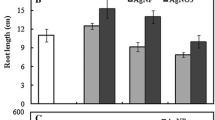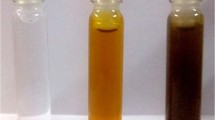Abstract
The purpose of this study was to analyze the effect of chemically synthesized silver nanoparticles (AgNPs) on in vitro regeneration of carnation cultivars cv. Noblessa, cv. Antigua and cv. Mariposa. Number of shoots/explant of cv. Noblesse and cv. Antigua significantly increased at 6 mg/L AgNPs (average 7.33 shoots per explant) when supplemented in MS media. While cv. Mariposa showed highest regeneration rate at 8 mg/L (average 10 shoots per explant). High concentration of AgNPs (12 mg/L) in the medium enhanced rooting response, number of roots/plant, and root length as compared with control. The fresh and dry weight of regenerated plants significantly (P < 0.05) increased at 6 mg/L. DPPH based free radical scavenging activity, total antioxidant activity and reducing power potential of regenerated plants varied depending upon concentration of AgNPs in the media. To find non-enzymatic antioxidants to combat oxidative damage, total phenolics and flavonoids were also determined in the regenerated plants. The study concludes that metallic nanoparticles has significant effect on in vitro growth of carnation cultivars however concentration dependent. Furthermore, nanoparticles can be effectively used for increased in vitro shoot multiplication and regeneration of floriculture plants.







Similar content being viewed by others
References
Abdel-Aziz MS, Shaheen MS, El-Nekeety AA, Abdel-Wahhab MA (2014) Antioxidant and antibacterial activity of silver nanoparticles biosynthesized using Chenopodium murale leaf extract. J Saudi Chem Soc 18:356–363
Ames BN, Shigenaga MK, Hagen TM (1995) Mitochondrial decay in aging. Biochim Biophys Acta 1271:165–170
An J, Zhang M, Wang S, Tang J (2008) Physical, chemical and microbiological changes in stored green asparagus spears as affected by coating of silver nanoparticles-PVP. LWT Food Sci Technol 41:1100–1107
Auffan M, Rose J, Bottero J-Y, Lowry GV, Jolivet J-P, Wiesner MR (2009) Towards a definition of inorganic nanoparticles from an environmental, health and safety perspective. Nature Nanotechnol 4:634–641
Bell PF, Chaney RL, Angle JS (1991) Free metal activity and total metal concentrations as indices of micro nutrient availability to barley [(Hordeum vulgare L. Klages]. Plant Soil 130:51–62
Bernard F, Moghadam NN, Mirzajani F (2015) The effect of colloidal silver nanoparticles on the level of lignification and hyperhydricity syndrome in Thymus daenensis vitro shoots: a possible involvement of bonded polyamines. Vitro Cell Dev Biol Plant 51:546–553
Chang S-T, Wu J-H, Wang S-Y, Kang P-L, Yang N-S, Shyur L-F (2001) Antioxidant activity of extracts from Acacia confusa bark and heartwood. J Agric Food Chem 49:3420–3424
Choi O, Deng KK, Kim N-J, Ross L, Surampalli RY, Hu Z (2008) The inhibitory effects of silver nanoparticles, silver ions, and silver chloride colloids on microbial growth. Water Res 42:3066–3074
Chopra VL (1986) Relevance of basic research in agriculture. Indian J Genet Plant Breed 46(1):181–184
Deb MS, Jamir N, Deb CR (2014) In vitro culture of immature embryos of Cinnamomum tamala Nees.—The role of different factors. Indian J Exp Biol 52(10):1003–1010
Dipankar C, Murugan S (2012) The green synthesis, characterization and evaluation of the biological activities of silver nanoparticles synthesized from Iresine herbstii leaf aqueous extracts. Colloids Surf B Biointerfaces 98:112–119
Ghosh A, Hossain MM, Sharma M (2014) Mass propagation of Cymbidium giganteum Wall. ex Lindl. using in vitro seedlings. Indian J Exp Biol 52(9):905–911
Hemalatha S, Lalitha P, Arulpriya P (2010) Antioxidant activities of the extracts of the aerial roots of Pothosaurea. Linden ex Andre. Der Pharma Chemica 2:84–89
Hernández I, Alegre L, Van Breusegem F, Munné-Bosch S (2009) How relevant are flavonoids as antioxidants in plants? Trends Plant Sci 14:125–132
Javed R, Usman M, Tabassum S, Zia M (2016) Effect of capping agents: structural, optical and biological properties of ZnO nanoparticles. Appl Surf Sci 386:319–326
Kähkönen MP, Hopia AI, Vuorela HJ, Rauha J-P, Pihlaja K, Kujala TS, Heinonen M (1999) Antioxidant activity of plant extracts containing phenolic compounds. J Agric Food Chem 47:3954–3962
Kanner J, Frankel E, Granit R, German B, Kinsella JE (1994) Natural antioxidants in grapes and wines. J Agric Food Chem 42:64–69
Koontz HV, Berle KL (1980) Silver uptake, distribution, and effect on calcium, phosphorus, and sulfur uptake. Plant Physiol 65:336–339
Krishnaraj C, Jagan EG, Ramachandran R, Abirami SM, Mohan N, Kalaichelvan PT (2012) Effect of biologically synthesized silver nanoparticles on Bacopa monnieri (Linn.) Wettst. plant growth metabolism. Proc Biochem 47(4):651–658
Kumar V, Ramakrishna A, Ravishankar G (2007) Influence of different ethylene inhibitors on somatic embryogenesis and secondary embryogenesis from Coffea canephora P ex Fr. In Vitro Cell Dev Biol Plant 43:602–607
Kumari M, Mukherjee A, Chandrasekaran N (2009) Genotoxicity of silver nanoparticles in Allium cepa. Sci Total Environ 407:5243–5246
Lee W-M, Kwak JI, An Y-J (2012) Effect of silver nanoparticles in crop plants Phaseolus radiatus and Sorghum bicolor: media effect on phytotoxicity. Chemosphere 86:491–499
Lü P, Cao J, He S, Liu J, Li H, Cheng G, Ding Y, Joyce DC (2010) Nano-silver pulse treatments improve water relations of cut rose cv. Movie Star flowers. Postharvest Biol Technol 57:196–202
Ma X, Geiser-Lee J, Deng Y, Kolmakov A (2010) Interactions between engineered nanoparticles ENPs and plants: phytotoxicity, uptake and accumulation. Sci Total Environ 408(16):3053–3061
Mahendra S, Zhu H, Colvin VL, Alvarez PJ (2008) Quantum dot weathering results in microbial toxicity. Environ Sci Technol 42:9424–9430
Mangal M, Sharma D, Sharma M (2014) In vitro regeneration in olive. Olea europaea L. cv, ‘Frontio’from nodal segments. Indian J Exp Biol 52(9):912–916
Mather C (2008) Value chains and tropical products in a changing global trade regime. International Centre for Trade and Sustainable Development, ICTSD, Geneva
Mazumdar H, Ahmed G (2011) Synthesis of silver nanoparticles and its adverse effect on seed germinations in Oryza sativa, Vigna radiate and Brassica campestris. Int J Advbiotechnol Res 2:404–413
McDonald S, Prenzler PD, Antolovich M, Robards K (2001) Phenolic content and antioxidant activity of olive extracts. Food Chem 73:73–84
Murashige T, Skoog F (1962) A revised medium for rapid growth and bio assays with tobacco tissue cultures. Physiol Plantarum 15:473–497
Neumann PM (2008) Coping mechanisms for crop plants in drought-prone environments. Ann Bot 101:901–907
Oktay M, Gülçin İ, Küfrevioğlu Öİ (2003) Determination of in vitro antioxidant activity of fennel. Foeniculum vulgare. seed extracts. LWT Food Sci Technol 36:263–271
Onamu R, Obukosia SD, Musembi N, Hutchinson MJ (2003) Efficacy of thidiazuron in in vitro propagation of carnation shoot tips: Influence ofdose and duration of exposure. Afr Crop Sci J 11(2):125–132
Pal S, Tak YK, Song JM (2007) Does the antibacterial activity of silver nanoparticles depend on the shape of the nanoparticle? A study of the gram-negative bacterium Escherichia coli. Appl Environ Microbiol 73:1712–1720
Pant M (2016) A minimal cost micropropagation protocol for Dianthus caryophyllus L.–a commercially significant venture. Indian J Exp Biol 54:203–211
Prieto P, Pineda M, Aguilar M (1999) Spectrophotometric quantitation of antioxidant capacity through the formation of a phosphomolybdenum complex: specific application to the determination of vitamin E. Anal Biochem 269:337–341
Razzaq A, Ammara R, Jhanzab H, Mahmood T, Hafeez A, Hussain S (2015) A novel nanomaterial to enhance growth and yield of wheat. J Nanosci Technol 2(1):55–58
Rezaei F, Moaveni P, Mozafari H (2015) Effect of different concentrations and time of nano TiO2 spraying on quantitative and qualitative yield of soybean. Glycine max L. at Shahr-e-Qods, Iran. Biol Forum 7(1):957 (Research Trend)
Rezvani N, Sorooshzadeh A, Farhadi N (2012) Effect of nanosilver on growth of saffron in flooding stress. World Acad Sci Eng Technol 6:517–522
Sack L, Holbrook NM (2006) Leaf hydraulics. Annu Rev Plant Biol 57:361–381
Sparnaaij LD, Koehorst HJJ, Segers TA (1990) The inheritance of premature flowering in regenerants from carnation ovaries. In: Integration of in vitro techniques in ornamental plant breeding. Proceedings, symposium. EUCARPIA, pp 68–73
Stampoulis D, Sinha SK, White JC (2009) Assay-dependent phytotoxicity of nanoparticles to plants. Environ Sci Technol 43:9473–9479
Stone V, Johnston H, Clift MJ (2007) Air pollution, ultrafine and nanoparticle toxicology: cellular and molecular interactions. IEEE Trans Nanobiosci 6:331–340
Yin L, Cheng Y, Espinasse B, Colman BP, Auffan M, Wiesner M, Rose J, Liu J, Bernhardt ES (2011) More than the ions: the effects of silver nanoparticles on Lolium multiflorum. Environ Sci Technol 45:2360–2367
Zafar H, Ali A, Zia M (2017) CuO nanoparticles inhibited root growth from Brassica nigra seedlings but induced root from stem and leaf explants. Appl Biochem Biotechnol 181(1):365–378
Zia M, Gul S, Akhtar J, Ul Haq I, Abbasi BH, Hussain A et al (2016) Green synthesis of silver nanoparticles fromgrape and tomato juices and evaluation of biological activities. IET nanobiotechnol 11(2):193–199
Author information
Authors and Affiliations
Corresponding author
Ethics declarations
Conflict of interest
The authors declare that they have no conflict of interest.
Additional information
Publisher's Note
Springer Nature remains neutral with regard to jurisdictional claims in published maps and institutional affiliations.
Rights and permissions
About this article
Cite this article
Zia, M., Yaqoob, K., Mannan, A. et al. Regeneration response of carnation cultivars in response of silver nanoparticles under in vitro conditions. Vegetos 33, 11–20 (2020). https://doi.org/10.1007/s42535-019-00074-9
Received:
Revised:
Accepted:
Published:
Issue Date:
DOI: https://doi.org/10.1007/s42535-019-00074-9




